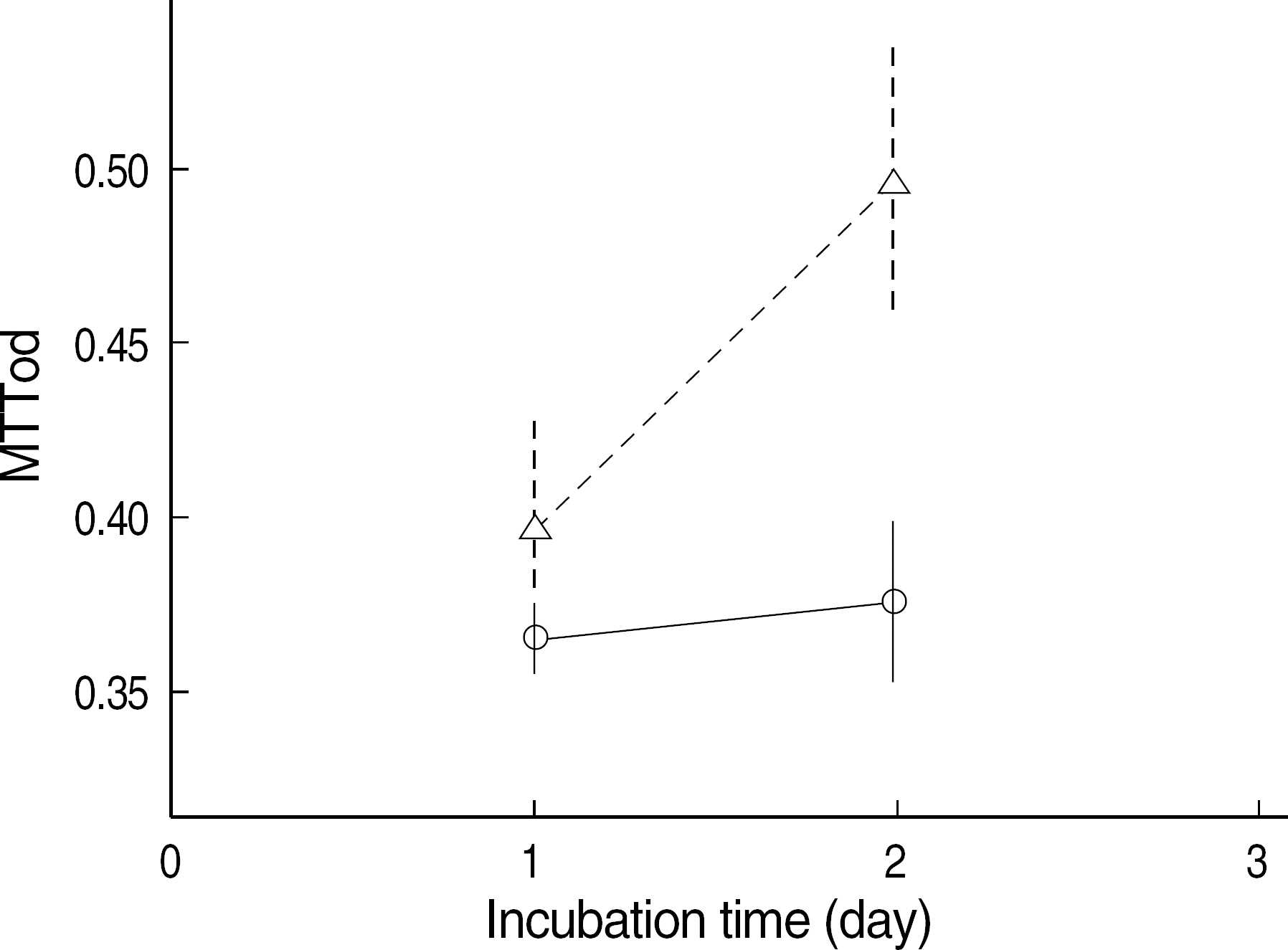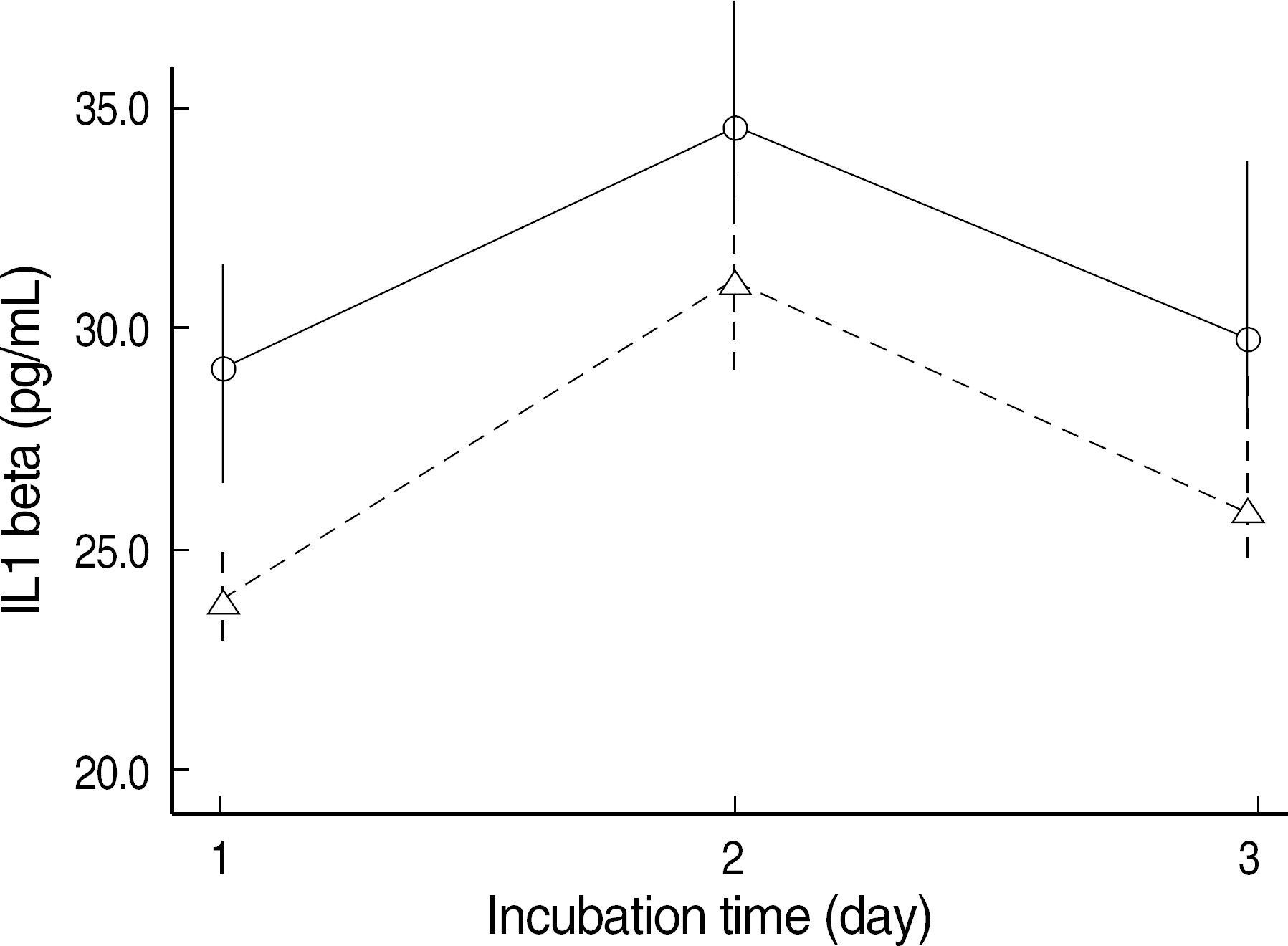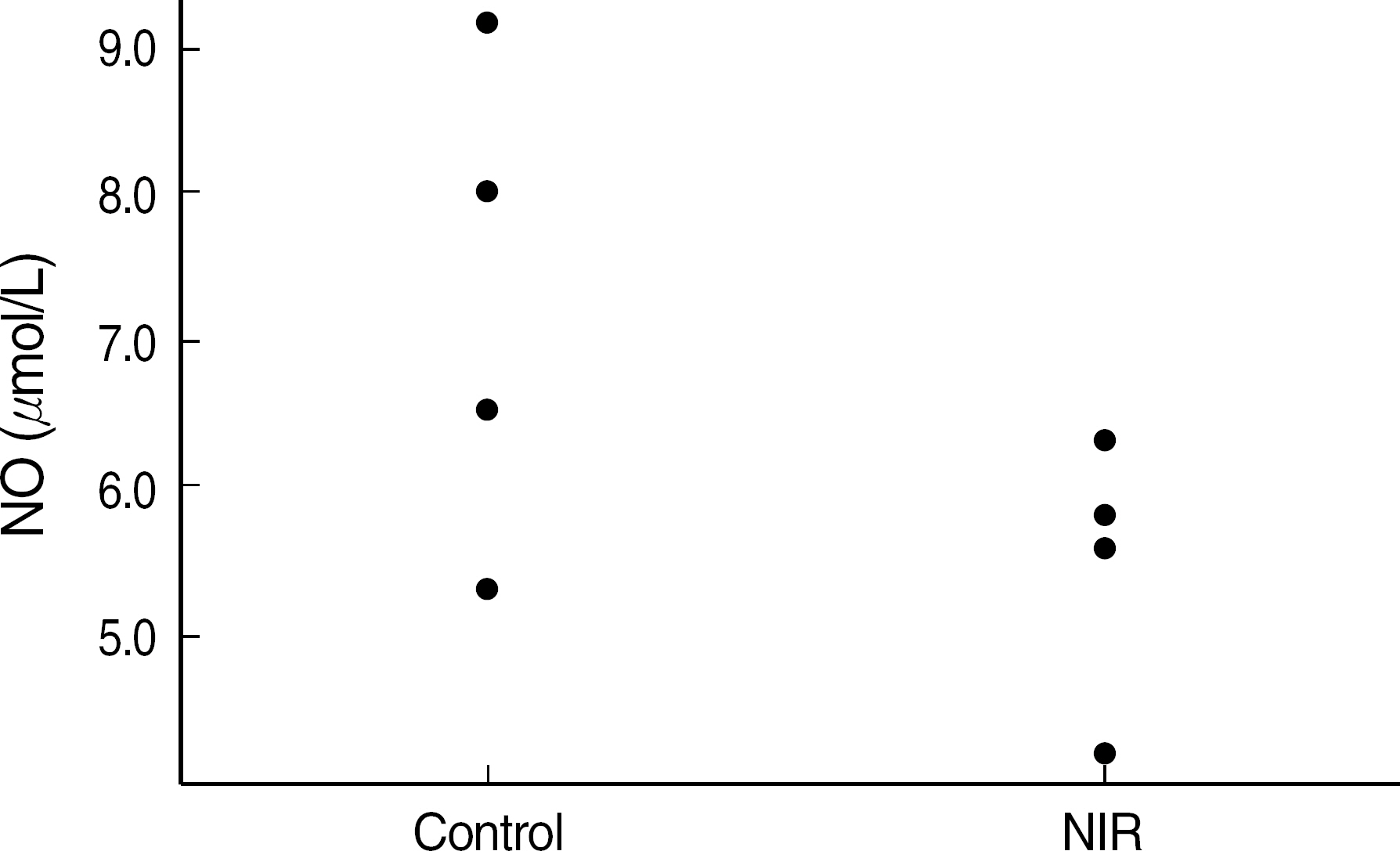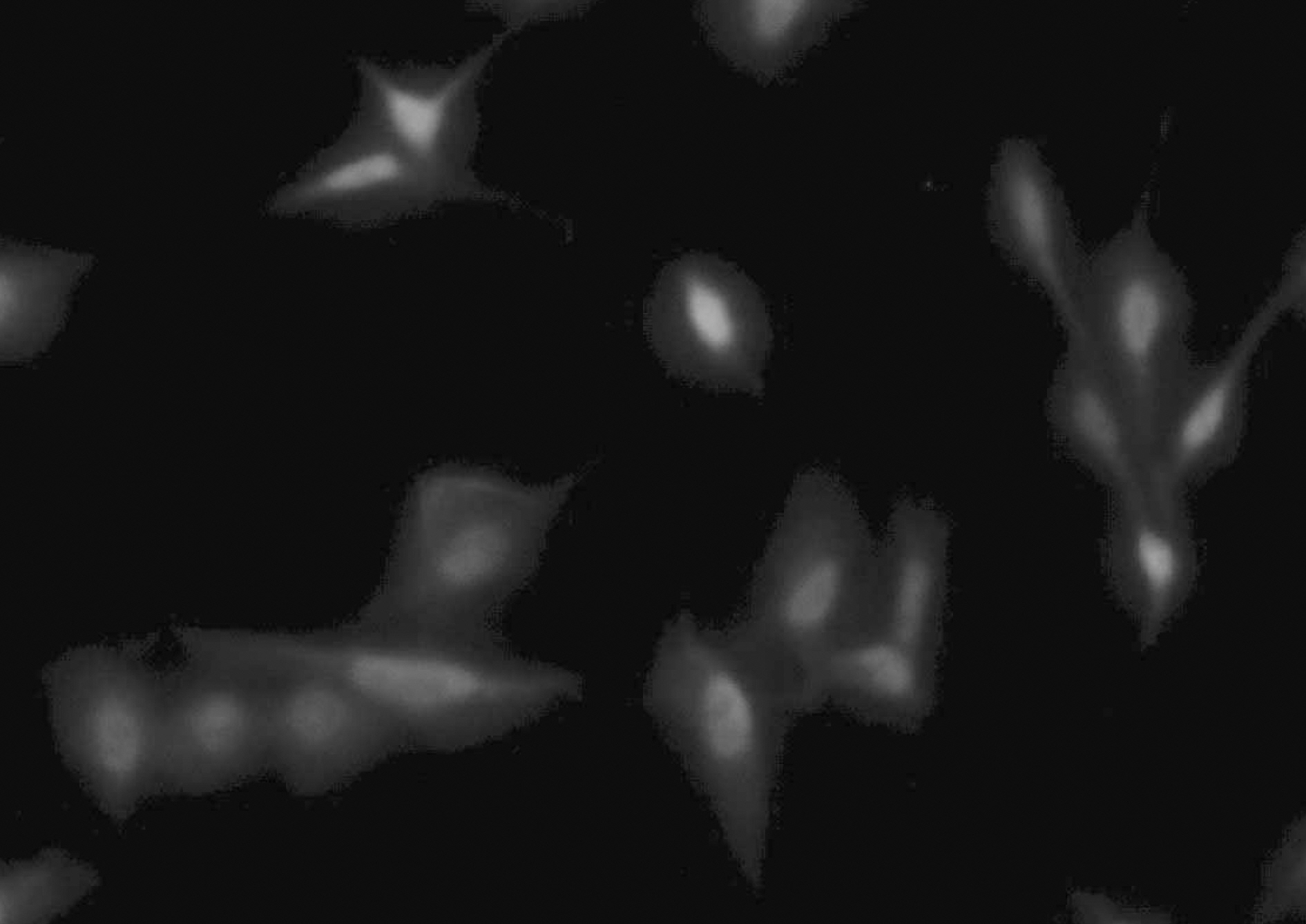Korean J Lab Med.
2009 Aug;29(4):338-344. 10.3343/kjlm.2009.29.4.338.
Anti-Inflammatory Effect of Near-Infrared Irradiated Cell Culture Media
- Affiliations
-
- 1Department of Laboratory Medicine, Catholic University of Daegu, School of Medicine, Daegu, Korea. sgkim@cu.ac.kr
- 2Department of Medical Statistics, Catholic University of Daegu, School of Medicine, Daegu, Korea.
- 3Department of Orthopedic Surgery, Catholic University of Daegu, School of Medicine, Daegu, Korea.
- 4Department of Internal Medicine, Catholic University of Daegu, School of Medicine, Daegu, Korea.
- KMID: 1096928
- DOI: http://doi.org/10.3343/kjlm.2009.29.4.338
Abstract
-
BACKGROUND: Near-infrared light (NIR, 0.8-1.5 micrometer light) has been used in therapeutic devices for various injuries such as infected, ischemic and hypoxic wound. NIR-emitting technology has been developed recently in Korea. We hypothesized that NIR may have an anti-inflammatory effect and investigated the effect of NIR-irradiated media on cell culture.
METHODS
Three kinds of cell lines, CAPE (vascular endothelial cell), NIH3T3 (fibroblast), and RD (smooth muscle cell) cells were cultured for 4 days in 10% FBS-containing media (1x10(4) cells/well), which were irradiated or not irradiated (control) by Eco-NFIR Drive (Model #0210, Ecowavetech, Korea). The cells were stimulated by 10 mcg/mL of bacterial lipopolysaccharide (LPS) or sodium nitroprusside (SNP). Cellular proliferation was measured by methylthiazol tetrazolium assay. Expression of interleukin (IL)-1 beta and nitric oxide was measured by ELISA. Expression of cyclooxygenase-2 (COX-2) and inducible nitric oxide synthase (iNOS) was measured by immunofluorescence staining.
RESULTS
NIR-irradiated medium was favorable for CAPE cell proliferation (N=8, P=0.000). IL-1 beta secretion from LPS-stimulated NIH3T3 cells incubated in the NIR medium was below that of control medium (N=4, P=0.026). Nitrate production seemed to be low in NIR-irradiated medium although statistically insignificant (N=4, P=0.076). Expression of iNOS of the LPS-stimulated cells was decreased in NIR medium, however, Cox-2 expression was not different between the two media.
CONCLUSIONS
NIR-irradiated medium supported vascular endothelial cell proliferation and showed an anti-inflammatory effect on fibroblast culture. These results can be used as basic data for future research on the clinical application of NIR.
Keyword
MeSH Terms
Figure
Reference
-
1.Wong-Riley MT., Liang HL., Eells JT., Chance B., Henry MM., Buchmann E, et al. Photobiomodulation directly benefits primary neurons functionally inactivated by toxins: role of cytochrome c oxidase. J Biol Chem. 2005. 280:4761–71.2.Eells JT., Wong-Riley MT., VerHoeve J., Henry M., Buchman EV., Kane MP, et al. Mitochondrial signal transduction in accelerated wound and retinal healing by near-infrared light therapy. Mitochondrion. 2004. 4:559–67.
Article3.Danno K., Mori N., Toda K., Kobayashi T., Utani A. Near-infrared irradiation stimulates cutaneous wound repair: laboratory experiments on possible mechanisms. Photodermatol Photoimmunol Photomed. 2001. 17:261–5.4.Kandolf-Sekulovic L., Kataranovski M., Pavlovic MD. Immunomodulatory effects of low-intensity near-infrared laser irradiation on contact hypersensitivity reaction. Photodermatol Photoimmunol Photomed. 2003. 19:203–12.
Article5.Mochizuki-Oda N., Kataoka Y., Cui Y., Yamada H., Heya M., Awazu K. Effects of near-infra-red laser irradiation on adenosine triphosphate and adenosine diphosphate contents of rat brain tissue. Neurosci Lett. 2002. 323:207–10.
Article6.Oh WS., In JY., Ha KH., Hong KH. Application of polarized light irradiation to meralgia paresthetica. Korean J Anesthesiol. 2000. 38:183–6. (오완수, 인준용, 하경호, 홍기혁. 직선편광 근적외선 조사에 의한 지각이상성대퇴신경통의치료경험. 대한마취과학회지 2000;38:183-6.).
Article7.Han SM., Lee SC. The change of blood flow velocity of radial artery after linear polarized infrared light radiation near the stellate ganglion: comparing with the stellate ganglion block. Korean J Pain. 2001. 14:37–40. (한승문 및 이상철. 성상신경절 부위의 직선편광 근적외선조사후요골동맥에서의혈류속도의변화: 성상신경절차단술과의비 교. 대한통증학회지 2001;14:37-40.).8.Kim J., Otzel D., Kim W., Janelle CM. Near-infrared light and expectancy effects on maximal isokinetic strength performance: a randomized, double-blind, placebo-controlled study. J Strength Cond Res. 2006. 20:378–82.
Article9.Choi CH., Lee HS., Seo HS., Kim SG., Shin IH. Biochemical changes and recovery after half-course marathon. J Korean Orthop Soc Sports Med. 2008. 7:45–9. (최창혁, 이현섭, 서헌석, 김상경, 신임희. 하프코스마라톤후체내의생화학적변화및회복. 대한정형외과스포츠의학회지 2008;7:45-9.).10.Kim SS., Kim WJ., Kim HE. The study of thermo-physiological responses with near infrared lighted garment at a hot environment. J Korean Soc Cloth Ind. 2005. 7:665–72. (김성숙, 김우종, 김희은. 서열환경에서 근적외선 조사의복 착용시의 온열생리반응. 한국의류산업학회지 2005; 7:665–72.).11.Park KH., Park YM., Seul KJ., Ghim SY. The indirect effects of the near infra-red light-treated materials on microbial growth. Korean J Microbiol Biotechnol. 2005. 33:222–5. (박경화, 박유미, 설경조, 김사열. 근적외선을 처리한 생활용품의 항균 효과. 한국미생물생명공학회지 2005;33:222-5.).12.Song JS. Review of tumor necrosis factor inhibitors on rheumatoid arthritis. J Korean Rheum Assoc. 2007. 14:1–14. (송정수. 류마티스관절염 치료에서 종양괴사인자억제제 사용에 대한 고찰. 대한류마티스학회지 2007;14:1-14.).
Article13.Denizot F., Lang R. Rapid colorimetric assay for cell growth and survival. Modifications to the tetrazolium dye procedure giving improved sensitivity and reliability. J Immunol Method. 1986. 89:271–7.14.Kim SG., Choe JY., Choi CH., Choi GH., Kim JK. Effect of culture condition on chondrocyte viability isolated from articular cartilage. Korean J Lab Med. 2004. 24:237–43. ((김상경, 최정윤, 최창혁, 최기환, 김종기. 관절연골조직으로부터 연골세포 일차배양시 배양방법에 따른 세포의생존력. 대한진단검사의학회지 2004;24:237-43.).15.Kim S., Temple MM., Chen AC., Sah RL. Effect of nitric oxide on cartilage homeostasis and chondrocyte viability. J Orhto Res. 2001. ;S18.16.Komorowska M., Cuissot A., Czarnoleski A., Bialas W. Erythrocyte response to near-infrared radiation. J Photochem Photobiol B. 2002. 68:93–100.
Article17.Whelan HT., Connelly JF., Hodgson BD., Barbeau L., Post AC., Bullard G, et al. NASA light-emitting diodes for the prevention of oral mucositis in pediatric bone marrow transplant patients. J Clin Laser Med Surg. 2002. 20:319–24.
Article18.Whelan HT., Smits RL Jr., Buchman EV., Whelan NT., Turner SG., Margolis DA, et al. Effect of NASA light-emitting diodes irradiation on wound healing. J Clin Laser Med Surg. 2001. 19:305–14.
- Full Text Links
- Actions
-
Cited
- CITED
-
- Close
- Share
- Similar articles
-
- The Effect of Serum Concentrations of the Culture Media on the in vitro Secretion of Free beta-subunit of Human Chorionic Gonadotropin by Ovarian Cancer Cells
- A Study on Tests of Skin Safety and Inhibition of Atopic Dermatitis Using a StoneTouch(R) Infrared Scanner in a Mouse Model
- The Effect of Blue Light on Propionibacterium acnes and the Expression of Inflammatory Cytokines in HaCaT Cells
- Effectsof Protein and Amino Acid(Glutamate) on the Development of Late 2-Cell Mouse Embryo in vitro
- Antioxidation and anti-inflammatory effects of gamma-irradiated silk sericin and fibroin in H 2O2-induced HaCaT Cell






